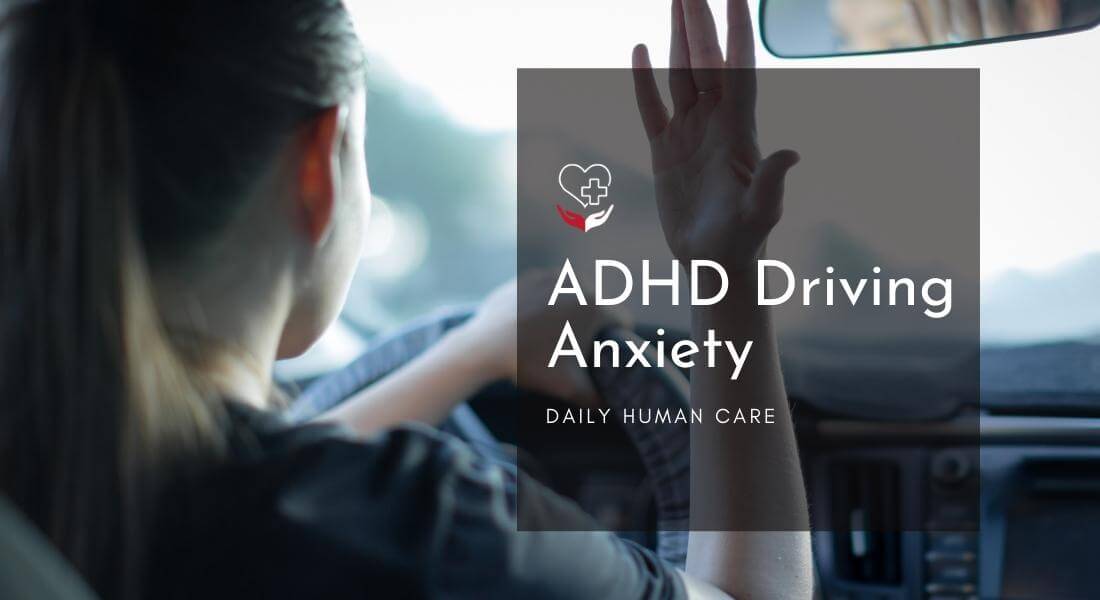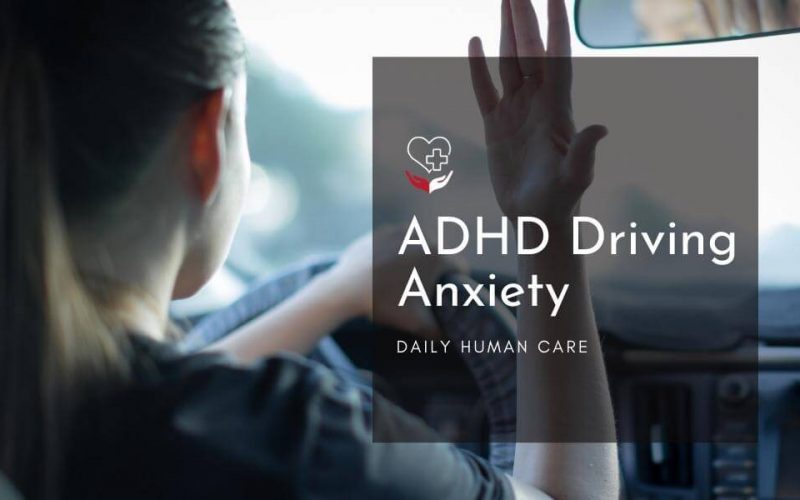People with Attention deficit and hyperactivity disorder are at great risk of driving anxiety. This article by Daily Human Care is all about providing you with knowledge about ADHD Driving Anxiety, Can ADHD cause driving anxiety? How do you drive a car with ADHD? How can I calm my anxiety while driving? how to teach ADHD teens and adults safe driving? And how to overcome the driving anxiety ADHD face during their trips?
Do you have driving anxiety? Do you know you are at risk of Driving anxiety when you are not ADHD?
Let’s start with Driving anxiety, then we will move on to ADHD Driving anxiety.
Table of Contents
Driving Anxiety
Many people experience anxiety and panic attacks while driving. Some people get a rush of anxiety just thinking about having to get behind the wheel. For some people, certain conditions, such as crossing bridges or passing through tunnels, can be particularly anxiety-inducing.
A mild level of discomfort to severe distress may be experienced by those who suffer from driving anxiety. People’s lives can be significantly impacted if the anxiety is not addressed. People who avoid driving because they are afraid of having a panic attack may end up stranded at home and isolated.
Self-guided exercises and psychotherapy are two effective methods for reducing feelings of anxiety while driving. Driving anxiety disorders can be alleviated by therapy, which helps about 80% of sufferers.

Signs of having Driving Anxiety
If you’re experiencing driving anxiety, you may notice a shift in your thinking as soon as you pick up the keys, or you may experience a gradual buildup of anxiety as you drive on the highway.
Driving anxiety symptoms include:
- Being agitated, tense, or nervous when you’re driving, getting ready to drive, or even just thinking about it
- After or during a car ride, feeling exhausted and worn out.
- Having a hard time focusing while driving.
- Irritability and rudeness toward others
- While driving, experiencing tension, especially in the neck and back.
- Having disturbing driving-related dreams.
The onset of these symptoms can occur suddenly or gradually over a period of time. A person with a driving phobia may be so terrified of the experience that they refuse to get behind the wheel at all. In doing so, they will be unable to interact with others and miss out on many positive aspects of life.
Signs of a Panic Attack While Driving
Signs and symptoms of a panic attack may include:
- Palpitations in the heart
- Sweating excessively
- Afraid to move
- Inability to inhale or exhale easily
- Pain and tightness in the chest
- a feeling of nausea or upset stomach
- Dizziness or lightheadedness
- Feeling the chills or being sweltering
- Feelings of numbness or tingling
- Disconnection from one’s physical self
- Fear of “going crazy” or losing control
- Death apprehension
Coping With a Driving-Related Panic Attack
Panic attacks can be frightening at any time. When you’re behind the wheel, it’s not only unpleasant, but it can also be dangerous.
Driving while having a panic attack requires deliberate and quick action. Immediately after a panic attack begins, a person should:
- When experiencing a panic attack, pay attention to the physical and mental feelings.
- Share your plan of action with the other passengers in the vehicle.
- Pullover instantaneously, but in a safe manner.
- Alert other drivers by turning on your hazard lights.
- In order to avoid traffic, stay in your vehicle
- Until the panic attack subsides, practice and use healthy coping skills.
There is a lot of fear and uncertainty when a person experiences a panic attack while driving for the first time. Though it may take time, they will discover a method for effectively reducing symptoms and ensuring their safety.
Effects of Driving Anxiety
Anxiety about driving can have a negative impact on a person’s physical and mental health and well-being in the short term, causing muscle tension and irritability. It can also have a long-term effect, causing them to avoid driving altogether and miss important appointments.
The following are some of the side effects of having driving anxiety:
- Constant tension in the muscles
- Tiredness or restlessness
- Changes in the heart rate and the level of stress in the body
- Driving while experiencing panic attacks increases your likelihood of having a collision.
- Because you are more concerned about driving, you may have a decreased ability to get around.
- If someone stops driving because of anxiety, it can lead to financial, housing, interpersonal, and professional difficulties.
ADHD DRIVING ANXIETY:
Attention deficit hyperactivity disorder (ADHD) is a common disorder that affects both adults and adolescents. Adults with ADHD must always be aware of how their symptoms may affect their driving, even if they have more driving experience. Driver’s licence suspensions, revocations, and accidents are more common for adults with attention deficit hyperactivity disorder (ADHD).

If a person with ADHD is aware of how their ADHD symptoms affect their driving, they can make better decisions while behind the wheel.
Greater risks
Adults with ADHD are more likely than non-ADHD adults to have poor driving incidents. No matter what else is going on, adults with ADHD have a higher accident rate than non-ADHD adults. An adult driver with untreated ADHD symptoms could be as impaired as someone who is driving under the influence of alcohol if they are not treated.
As a result of a lack of executive function and other symptoms of ADHD, individuals are more likely to find themselves in potentially dangerous situations. Inattention and impulsivity can both lead to poor reactions to other drivers and traffic conditions, as can a lack of concentration. In spite of having less experience behind the wheel than their peers, adults with ADHD often exaggerate their abilities when it comes to driving.
Distracted driving
Texting and talking on a cell phone while driving is illegal in many states. A total of 3,300 people were killed in 2012 because of distracted driving, according to the National Highway Traffic Safety Administration (NHTSA).
All, most, or on some trips, according to the NHTSA, more than three-quarters of all drivers are likely to answer their cell phones. It’s also common knowledge that drivers don’t take traffic conditions into account when they’re on their phones.
In periods of low stimulus or monotonous driving, ADHD drivers appear to be particularly vulnerable to distractions.
If you’re driving a long distance or on a highway, high speeds can increase the risk of a serious crash. Distractions can be as simple as changing the radio station, applying make-up, drinking or eating something, or conversing with another driver. In-vehicle entertainment systems and young children in the backseat both pose distraction risks that parents should be aware of. With ADHD driving anxiety, poor driving is more likely to lead to car accidents and fatalities.
To help adults with attention deficit hyperactivity disorder (ADHD), they may want to put their cellphones and MP3 players away or turn them off, and they should also refrain from eating or drinking. Driving with less irrationality is easier when you’ve done your homework and know where you’re going.
Experts on teen drivers with ADD/ADHD Driving Anxiety
Experts believe that a significant amount of intervention is needed during the driver training stage in order to improve the safety of a child with ADD/ADHD. Drivers’ education programmes traditionally do not differentiate between children with and without AAD/ADHD, so parents bear the brunt of their children’s training burden.
Driving should be taught to ADD/ADHD teenagers as early as the age of 14, according to some experts. Parental influence, instruction, and the development of safe driving habits are all possible while children are under the legal guardianship of parents until the age of eighteen.
Teaching Teens with ADD/ADHD to Drive
Incentives for safe practice driving calmly can be set up. Similar to other systems used with children with ADD/ADHD, this behaviour incentive system allows teens to earn practice driving time with their parents for each increment of appropriate behaviour at home. You can begin this program as early as age 14, but only if you have access to private back roads in your area.
Using Practice time
You should allow your child to practice with you for at least 20 minutes per outing. A lot of practice will help them learn how to drive on their own someday. During the time spent driving practice, bring up the unique difficulties faced by drivers with ADD/ADHD driving anxiety. Ask the child if he or she was distracted by something. How do you know this? Then, ask them to reflect on what they’ve learned. These can assist them in taking responsibility for a number of the difficulties they face and raise their level of consciousness.
Setting limits
A learner’s permit is a crucial first step in driving legally. Make sure your child understands that you won’t sign for the learner’s permit unless he or she abides by certain rules. Allowing minors to drive only with the presence of a parent or driving instructor is just one example of these rules. Other examples include driving for certain miles before being allowed to apply for a driver’s license.
ADHD Driving Anxiety in Adults
Adults with Attention-Deficit/Hyperactivity Disorder (ADD/ADHD) are more likely to have poor driving incidents. People with untreated ADD/ADHD may be incapable of driving in a way that is similar to driving while intoxicated. ADD/ADHD adults have a well-documented tendency to overestimate their driving ability.
There is evidence that drivers with attention deficit disorder (ADD/ADHD) are more vulnerable to distractions while driving in low-stimulus or dull conditions. In addition to not eating or drinking, adults with ADD/ADHD driving anxiety can benefit from putting away or turning off their cell phones and MP3 players.
The ability to control one’s impulses while driving can be enhanced by planning ahead of time and becoming familiar with the route to one’s final destination. Adults with ADD/ADHD have an advantage over younger drivers because of their experience behind the wheel, but the symptoms can persist throughout a driver’s career.
Driving Skills & Driver Safety Enhancements of people with ADHD driving anxiety:
If you have ADHD and driving anxiety is a great problem for you, by using the following safety measures you can reduce your ADHD Driving anxiety
Reduce:
Distractions in the car, including electronic devices, should be minimized.
Know:
Use turn signals/indicators, blinkers, and speed zone requirements in accordance with state traffic laws. If you have questions about a specific law, contact your state’s Department of Motor Vehicles.
Attend and pass:
If necessary, enrol in and complete a driver education course that addresses ADD/ADHD issues.
Supplementary Driver Training for the person with ADHD driving anxiety
Some ADD/ADHD driving with anxiety symptoms may necessitate specialized driver training, such as learning to control negative emotions or improving one’s ability to concentrate.
People with ADHD driving anxiety only drive when absolutely necessary, such as to and from school, sports events, or jobs during the summer or after school. For the first six months, no nighttime driving without a parent present. Before embarking on a trip, make sure to discuss it with your parents. For at least the first three to six months, no passengers but parents are allowed. Only one passenger is permitted for the first year or two after that.
All passengers should be vetted by parents before they are allowed to board. All alcohol and other illegal substances are banned. Once your child has completed a treatment program, immediately revoke all driving privileges. Once you’ve dealt with your substance abuse issues, don’t give up your car keys. Every trip should be documented, so make sure to do so. All of this information should be recorded by teenagers in order to help them remember their journeys in the future. The log can then be used to brainstorm strategies for improving concentration and averting problems for both parents and teens.
ADD/ADHD Driving Anxiety Controlling Safety Tips
Recognize that you may be suffering from a disorder that will have an effect on your ability to drive safely. To drive safely, people with ADD/ADHD must maintain a laser-like focus on the road ahead. Unlike other drivers, they may need extra help to do so.
Please don’t drive while using your smartphone. In order to prevent incoming calls, drivers with ADD/ADHD driving anxiety who use cell phones should turn them off, only use them in an emergency, and pull over whenever they make a phone call. Taking notes while driving is a bad idea.
Limit your music options and sources. Listening to music can help some people with ADD/ADHD driving anxiety to stay focused while driving. A lot of people find it annoying. Choose a music source that doesn’t have a lot of distracting fumbling. Never change the station on the radio while driving; if you must use a cassette or CD player, limit yourself to one per trip in order to avoid the temptation of rummaging through a stack of discs.
Choose your passengers wisely, or take a solo ride. Having other people in the car can be a major distraction, especially if the passengers are ADD/ADHD teens or ADHD parents. If at all possible, have your passengers sit in the back of the vehicle so that they don’t interfere with your driving.
Make travel plans in advance and leave yourself plenty of time to get where you want to go. A pre-planned journey lets drivers concentrate on the task at hand rather than on figuring out the route. Not only that, but you’re less likely to speed or run red lights if you don’t get lost. It’s best to consult a map when you’re not driving so you can concentrate on what you’re reading. Do not drive without first planning your destination and the route you will take to get there.
Are you still at risk of having driving anxiety when you are not with ADHD?
There isn’t a single cause of driving anxiety; it could be brought on by a history of anxiety in the family or a recent accident. Nature and nurture can also play a role.
As a result of driving-related anxiety, there are a number of factors to consider:
- A Recent Accident
The most obvious cause of driving anxiety is a recent accident. Post-traumatic stress disorder (PTSD), acute stress disorder, adjustment disorders, and phobias can all be triggered by an accident. Approximately one-third of people who have been in a car accident report having anxiety-related symptoms.
- Inclement Weather
Some dangerous driving situations don’t end in a collision. A new set of anxieties may arise when driving in adverse conditions, such as heavy snowfalls, fog, or flooding rains.
- Specific Phobias Like Agoraphobia
Anxiety while driving can be exacerbated by a fear of crowds or wide-open spaces, such as in agoraphobics.
- Triggered by Bridges & Tunnels
Even if a person does not have a specific phobia, bridges and tunnels can elicit a fear response. Tunnels can make people feel confined and trapped, while bridges can conjure up images of collapsing or people driving over the side of the structure.
- Triggered by Highway Driving
Driving fast along a highway means more cars, more lanes, more distractions, and a greater potential for injury or death. Inexperienced drivers may feel overwhelmed and overstimulated by all the activity on the expressway.
- Early Signs of Dementia & Aging
Because of the ageing process, people’s reaction times and physical responses slow, resulting in an increase in stress and pressure. Panic attacks may also become more common as a result of cognitive decline and the earliest signs of dementia.
- Visual Impairment
Some people will experience driving anxiety because they have poor vision. An optometrist should be contacted if you are experiencing dizziness, lightheadedness or a loss of balance while driving.
- Family History of Anxiety Disorders
People who have a family history of anxiety disorders are much more likely to develop anxiety themselves. Driving-related anxiety is just one way this could be expressed.

5 Tips to Get Over Driving Anxiety:
Driving anxiety can be a powerful force in a person’s life, but there are many ways for an individual to cope with this anxiety. You can begin to overcome your anxiety by taking steps to understand your anxiety, exploring strategies that minimize symptoms, and implementing behavioural interventions.
Driving can cause feelings of panic and anxiety, so here are five ways to deal with them:
-
Become More Familiar with Your Panic
A better understanding of the root causes of your driving anxiety can help you develop coping mechanisms to lessen the effects. Identify the people, places, and things that have a role in your driving-related anxiety by tracing your journey back to when it first started and how it has progressed.
Did your parents show signs of driving anxiety or were these symptoms brought on by a recent accident? Is your anxiety constant or is it triggered only when you’re driving by yourself?
Identifying whether or not driving anxiety is the root cause or merely one symptom of a larger issue is critical. For those with PTSD, OCD, or any other serious anxiety disorder, professional treatment will be necessary to address the underlying issues that are causing the driving issues.
-
Set Goals for Yourself That You Can Achieve.
With the goal and method of achieving it in mind, you’ll need to be deliberate throughout this process. Think about the long- and short-term ramifications of your decisions.
If you want to be free of anxiety while driving for the long term, you’ll probably follow a certain path. If you only want to get rid of your anxiety for a short period of time, there are other options. In the end, it’s up to you, but keep in mind that what’s best in the short term isn’t always best in the long run.
- Observe the Effects of Relaxation.
With the goal and method of achieving it in mind, you’ll need to be deliberate throughout this process. Think about the long- and short-term ramifications of your decisions.
If you want to be free of anxiety while driving for the long term, you’ll probably follow a certain path. If you only want to get rid of your anxiety for a short period of time, there are other options. In the end, it’s up to you, but keep in mind that what’s best in the short term isn’t always best in the long run.
- Inhaling and exhaling deeply.
- Doing PMR, in which one group of muscles is tense and then relaxed one at a time.
- Using your imagination to conjure up images of serenity and peace can help you unwind.
- Meditations on mindfulness
- As a form of stress reduction, autogenic training replaces anxiety-inducing thoughts with positive self-talk.
-
Bring in Your Friends and Family that support you
You may be able to overcome your fear of driving on your own, but it’s always more rewarding and fun to tackle a difficult problem with your friends and family. Bring your support system with you if you need help managing your driving anxiety.
Driving anxiety may be alleviated by the following:
- Giving you a refresher on how to cope
- Recommending new methods for dealing with stress
- Preserving your sanity
- Relieve stress and anxiety by travelling with you
Driving-related anxiety can be alleviated simply by telling your story to others. The healing process and speed of recovery can be aided by sharing your stress and struggles with others.
-
When it comes to exposure, start small and work your way up
As much as it may be tempting, you should not take harsh action to overcome your fear of driving. Avoid putting yourself in a situation where you will not succeed.
You can reduce your fear of driving by focusing on the things that cause you anxiety while driving. Consider this:
- When did the anxiety start?
- What causes a person’s stress level to rise to a critical point?
- How long does it take for the symptoms of anxiety to subside?
- What is the sensation of anxiety like?
You can lessen your anxiety while driving by identifying and focusing on the aspects of the activity that cause you mild anxiety, and then practising these techniques on a regular basis while also employing relaxation techniques.
In order to alleviate your driving anxiety, you must expose yourself to ever more stressful aspects of it. Your symptoms won’t improve unless you get some direct sunlight.
Do not try to move too quickly, as this can exacerbate any anxiety you may have about driving already present.
Also; read about the co-occurrence of anxiety and mood disorder.




